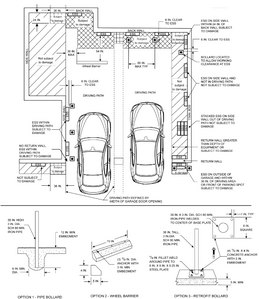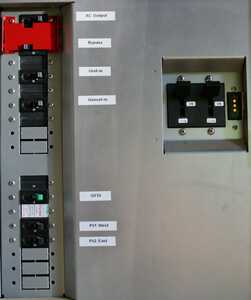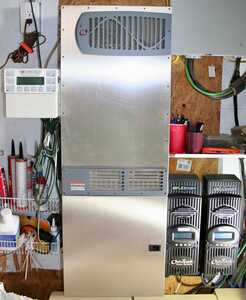New Member Sharing my system
I am new to solar power and have a lot to learn. I am a retired Technician/Engineer (Electronics /Tech, Computer/Electrical and Radar Engineer) living outside Tucson AZ. I have a Parallel set of 12000XP's connected to 24 540 W bifacial panels (2 strings of 8 and 2 strings of 4, all set to 32 degrees elevation at 175 degrees south) with 5 EG4 48v batteries in parallel in a rack. I am hoping to take my entire house off grid, but will do it in stages.
I completed the first stage yesterday, When I moved 1 (of 2) 100 amp subpanels (washer/dryer/water heater/water softener/some lights/outlets) from the grid to the solar. I moved the second 100 amp subpanel (garage electrics, welders/wood working equip/compressors, etc). I also moved my pool pump room (a 50 amp heater circuit and a 30 amp subpanel for the pumps/lights/control system). I ran this two nights and the only big hit I saw was the water heater (3000W for 15 minutes at 3am). Both mornings I met the rising sun with 80% SOC. When the pool heat pump kicked on I suffered the code 28. Found my 12000xps had different (and older) firmware.....updated it and problem went away.
Stage 2 (this week), I will move the rest of the house EXCEPT the 3 ton AC from grid to solar (about 20 more circuits). I intend to let this run for a month so that I can see how the system is sized (i.e. do I need more panels or batteries?) and also to get a clean bill from the electric company of just the solar (in July in Tucson) to help make sure the math shows I have enough solar/batteries.....
I wish a good tutorial existed for settings on the 12000xp in parallel.....
Thoughts?
@eg4eric Everything is working, (since i updated the software to make the overloads stop). Waiting to hear if the new update fixed the DST issue (I live in Tucson, no DST). My only concern is that I wish a more detailed description of the settings exisited.....
My next step is running grid power to each unit and switching over the A/C unit.
Thx
@rev114
I understand! At the moment, the DST issue has not been resolved yet, but we’re actively working on it. Once it’s fixed, we’ll notify everyone. We apologize for any inconvenience this may cause.
I do not have land to build a decent solar array. So, after thinking a bit. I came to the conclusion that a "free nights" plan and enough batteries would save money. My home is ~4000 sq ft and with an average free nights plan I use between 30 kwh to 40 kwh during the non-free time of use. The plan is 6am to 8 pm (non-free time of use) billed at roughly 25 cents per kwh and 0 between 8 pm and 6 am (free time of use). So, I did the research on battery kwh storage size, physical size of batteries based on code requirements in a garage, ROI of equipment and state code limits on a battery bank in a residential environment.
So this became my solution:
Garage Return Wall had 12.5 inch space limit; So battery had to be less than 11.5 inches depth. Otherwise bollards would be needed in garage (see attached pic).
Max kwh limit in Texas for residence ESS (Energy storage System) is 80kwh; 5xEG4 280ah 14.3kwh batteries equals 71.5 kwh. This gives 42.9 kwh usable storage.
Wall mounted batteries would be required to stand on floor to limit stress on wall; EG4 240ah 13.3kwh batteries weigh 300+ lbs. and have feet to stand on.
Battery Electrical design would need to allow isolation of equipment if maintenance is ever needed (like removing and replacing an inverter and/or battery); Transfer switch(es)/Breaker(s) and bus bars/taps were added to design to allow isolation.
The added image should assist anyone interested in the same solution. This has run for a few days. The Energy Usage Chart from SmartMeterTexas is also attached. Average Electric bill per month (even in summer) is less than 5 bucks. What do you think of my solution?
Impressive setup!
I have been on True Free nights for 12 + 12 + 58 months here in TX and finally Reliant refused to extend it further or offer any other free nights plan to my address anymore. It seems that the Sun is more reliable free electricity provider than humans :).
If you could add PV arrays in the range of 20kW that would be Doomsday proof.
With Your setup multiple small in series arrays are possible - impressive.
I have functionally very similar setup, but way smaller - just single 6000xp with one wall mount battery, 3.5 kW solar array and 2 hybrid mini-split A/C installed resulting in 5-6$ a month electricity bills for 2.5k sq ft house in Houston - as long as true free nights electricity plan is available.
If that option is not available - then more panels and more batteries will be needed....
Just my 5 cents
Brgds
K
To put Sun as free electricity provider in context :
Having tiny single 3.5kW PV array (on my small south facing patio roof) I have recorded 22kWh cumulative production in one sunny April day.
Even during fully clouded 'dark' days the solar production anti-recorded 3.5 kWh daily power production. Sun 'rulez'
Brgds
K
My wife, Mary, and I built our retirement home in the Talladega National Forest in 2013. It would be our 2nd off-grid solar system (the first being in northern Idaho). After over a decade of use, the original 750ah commercial flood acid battery was due for a replacement. So, a rack of EG4 Lifepower4 (V1) became our new energy storage. That would become the beginning of a long transition from our original Outback Power system to a complete EG4 system. The original Outback system was comprised of:
- 24 ReneSola 305W JC305M-24/Ab Solar Panels (8 strings of 3, 2 arrays) for a total power rating of 7320 watts, but can actually produce signicantly more
- Outback Power Radian 8KW GS8048 Parallel Inverter/Charger
- Outback Power Load Center GSLC175-PV-120/240 w/FNDC
- Outback Power MATE3 (later replaced w/a MATE3S) System Display and Controller
- 2 Outback Power FlexMax80s MPPT Charge Controllers
- Outback Power Battery Temperature Sensor
- Outback Power HUB10
- Outback Power FWPV-12 Combiner Box, 8 strings, 2 Midnite Solar Surge Protectors on 2 runs
- 24-125-13 48V 750AH GB Industrial Battery w/watering system
- Yanmar Slow-Turning, Energy Efficient 5KW 240V Diesel Generator w/AGS
- IronRidge 3” Ground Mount System
When I finally got around to replacing the FLAB, I went ahead a purchased a 2nd rack, but by then the LL (V2) was available. Since Outback was getting further and further behind in technology, I had to manually set and play with all of the parameters for the new EG4 batteries.
Later, I purchased 2 EG4 6000EX-48HV inverters as a BACKUP to the Outback system. Since I took my sweet time to even bother installing them, by that time the 18Kpv became available with a trade-in credit for the 6000EX's. I finally got the 18Kpv on the wall, but only had the battery racks connected to remotely monitor battery SOC. Even that was only partially working, as the Lifepower4's were not being seen by the 18Kpv, even with the 3.40 battery FW. And the capacity of the 6 LL's was only 300A, later rectified with communication protocol and battery type set correctly.
A EG4 Chargeverter was also added to the system - highly recommend for any generator charging, but that's another topic.
I continued to dilly dally around finishing the 18Kpv install as it was merely a backup and there was an incompatibility between the two systems that did not allow for just adding a switch between the two: the much higher charge controller voltage of the EG4 system.
A couple months ago, we got a direct lightening strike on our home. It took out our well pump, three computers, two network routers, and of more interest here, the NIC on the Outback MATE3s. In addition, it seems to have damaged the FNDC so that the readings are inaccurate. Though the Outback inverter is a solid performer, I have no interest in pouring more money into replacing the MATE3s and FNDC, since Outback has not demonstrated any technology development over the past few years. So now I'm a bit more motivated to get the EG4 system completed, and use the Outback inverter as a backup.
First, to get the remaining Lifepower4 batteries communicating with the 18Kpv. I ordered a Lifepower4 V1 automatic updater, but it actually downgraded the FW from 3.40 to 3.37. Very frustrating, as FW V3.40 has been available for a year. To top it off, tech support told me that the automatic updater could not be updated with newer FW, and that I had to use BMS Test to do the upgrade. Done. Now I'm waiting on the Automatic Updater for the LL batteries. Though they were updated last year with the "multipack" FW, tech support suggested that as a next step, after reviewing my current configuration.
Second, will be to rewire the solar panels for the higher EG4 PV input voltage. This will require combining the 4 strings in each array into a single string and replacing the breakers.
Lastly, running the 18Kpv AC output through the Outback bypass switch. This will at least allow me to switch to the Outback inverter as a backup.
Sound like a good plan?
Wish me luck!
- 35 Forums
- 911 Topics
- 4,932 Posts
- 8 Online
- 1,475 Members











